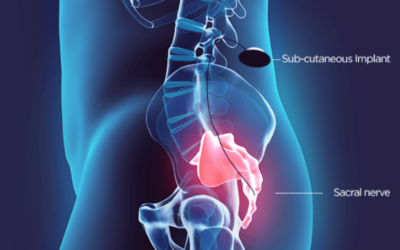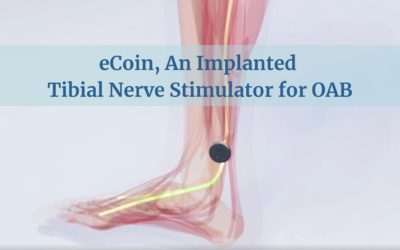Overactive bladder (OAB) is so common. We think that more than 35 million Americans have it. We don’t really understand exactly why this happens. But we know that it involves how the bladder nerves and muscles function and communicate. Stimulating the right nerve can decrease or even cure bladder symptoms. So what bladder nerve stimulation procedures are out there?
Percutaneous tibial nerve stimulation (PTNS)
How it is done
The tibial nerve is a branch of the sciatic nerve. It runs down the back of your leg. Stimulating this nerve by the inside of your ankle improves overactive bladder symptoms. The stimulation is done by placing a small needle (very similar to an acupuncture needle) through the skin near the nerve. The needle is then connected with a wire to an electrical stimulator. The intensity of the stimulation is controlled and can be increased or decreased. You can feel the sensation but it should not be painful. I tried this procedure so I would know what it felt like. The needle placement is a little uncomfortable but that the stimulation was not. And I’m pretty wimpy about these things.
The nerve stimulation lasts for 30 minutes. It is repeated once a week for 12 weeks. Most women do not notice an improvement until the 6th session. After the initial treatment sessions, you need “booster sessions” to maintain the effect. How frequently you need these sessions varies but is likely to be once every month or so.
How well is works
PTNS is a nerve stimulation that works in 60-80% of women. There really aren’t any side effects, maybe just a little irritation at the needle site. I usually say that the only negative is the time it takes every week. But I may have to stop saying that. A friend of mine (and not a patient!) is getting this procedure and she told me that she loved it because of the time in the office. She found the 30 minutes of quiet time to be a gift. Which just shows how busy we all are.
Sacral neuromodulation (SNS)
How it is done
Stimulating the third sacral nerve controls OAB symptoms as well. This nerve is in your lower back above the tailbone. To stimulate this nerve, a surgeon places a permanent lead near the nerve and then attaches the lead to a battery which provides the electrical stimulation.
The battery and wire are placed in a two-step, outpatient procedure in an operating room. The first step is a trial. You live with the device for a week or two to determine how well it works for you. If your symptoms are at least 50% better, the battery is placed under the skin. Your improvement is measured by tracking your symptoms and your leaks.
I really like this procedure because of the trial period. There aren’t many procedures that you get to “try” before deciding if you like it. But during the trial, there is a wire that comes out of the skin and this can be irritating. The risks of the procedure are the same as most surgeries and include pain, bleeding, and infection. The nerve that is stimulated has both motor and sensory function. This means that when certain parts of the nerve are stimulated, you may feel different pelvic sensations or feel different muscles contract. There are lots of different ways to program the device which will change what you feel and how it works. SNS also treats fecal incontinence.
How well it works
SNS is a nerve stimulation that works in 60-90% of women. It cures the leakage in 30-50%. The batteries can be rechargeable which extends their life. The batteries do need to be replaced over time and this requires a surgery. There are two different companies the provide this technology, Medtronic and Axonics.
These procedures seem a little crazy to many women. It can be hard to envision how they work and what they will feel like. They definitely are not the first line treatment for OAB. There are lots of other things to try first. But in the right woman, they are a great option. And it is always good to know what treatments are out there.
Leron E. et al. Overactive bladder Syndrome: Evaluation and Management. Curr Urol 2018;11(3):117-125.
Lucacz ES et al. Urinary incontinence in women: a review. JAMA (2017);318(16):1592-1604.






0 Comments